A needle threader emerges as a discreet yet indispensable ally in the intricate sewing world. This small tool revolutionizes the seemingly simple yet often challenging needle threading.
Comprising a slender wire loop attached to a handle or pendant, the needle threader is a guiding force, particularly for individuals with visual impairments or unsteady hands.
Its purpose is straightforward yet transformative – to effortlessly navigate the thread through the needle eye, rendering this once meticulous process quick and accessible.
In this exploration, we delve into the significance of the needle threader, unraveling its role as a facilitator in the art of sewing.
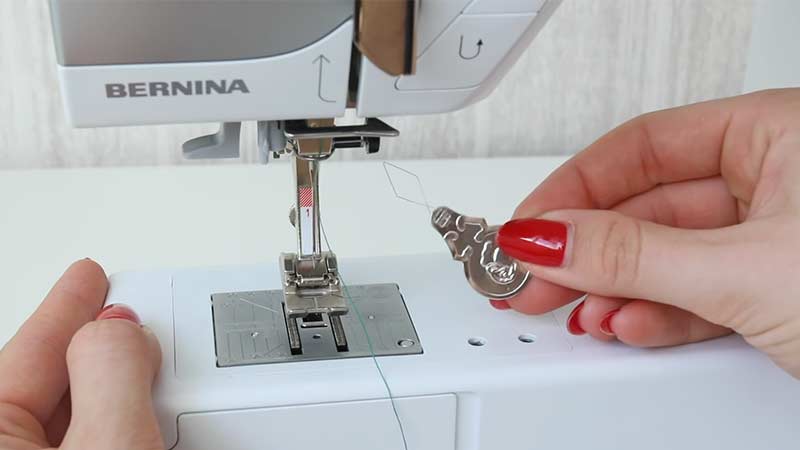
What Is a Needle Threader Used for in Sewing?
A needle threader is a vital tool in sewing, designed to simplify threading a needle. A thin wire loop attached to a handle or pendant aids individuals with poor eyesight or unsteady hands.
To use, the wire loop is inserted through the needle eye, and the thread is threaded through the loop. Pulling the loop back through the needle’s eye brings the thread, successfully threading the needle.
This small but invaluable tool streamlines the sewing experience, making needle threading efficient and accessible, especially when working with small needles or fine threads.
How Does a Needle Threader Work?
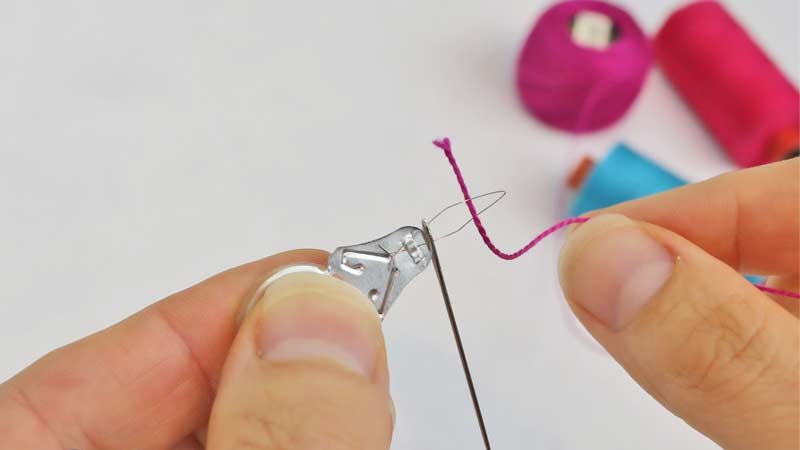
A needle threader is designed to simplify threading a needle, especially when working with small needles and fine threads. The basic design of a needle threader typically involves a thin wire loop attached to a handle or pendant.
Here’s a step-by-step explanation of how a needle threader works:
Insert the Wire Loop Through the Needle’s Eye
The process begins by holding the needle threader, ensuring the thin wire loop is easily accessible. With precision, the wire loop is inserted through the eye of the needle, navigating the narrow opening from the front to the back.
Place the Thread Through the Wire Loop
Once the wire loop is securely through the needle eye, the user takes the end of the thread and threads it through the wire loop of the needle threader. This essentially prepares the thread for the next crucial step.
Pull the Wire Loop Back Through
The magic of the needle threader lies in its flexibility. With the thread now caught in the wire loop, a gentle pull is applied to draw the wire loop back through the eye of the needle.
As the loop traverses the needle eye, it effortlessly brings the thread with it, successfully threading it.
Remove the Wire Loop
After completing the threading process, the final step involves carefully removing the wire loop from the threaded needle and the thread itself. This ensures clean and successful threading, leaving the needle ready for use in the sewing project.
Why Is Threading a Needle Challenging Without a Needle Threader?
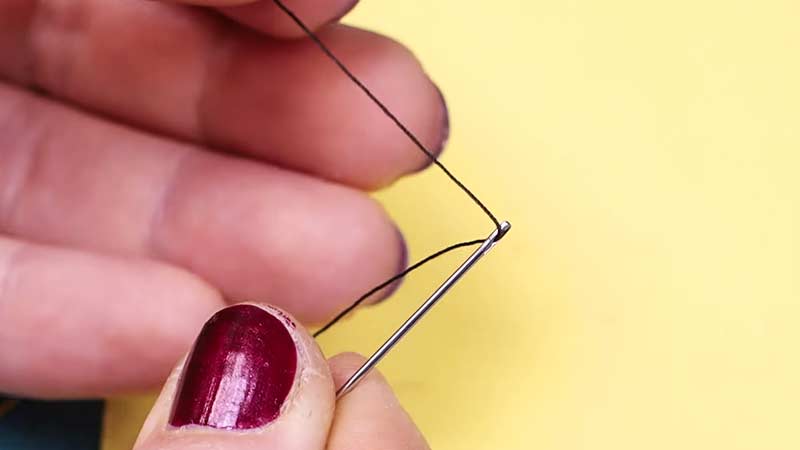
Threading a needle without a needle threader can pose challenges, turning a seemingly straightforward task into a meticulous and sometimes frustrating process.
Several factors contribute to the difficulty of manual threading:
Small Needle Eye
Needles, particularly those used for delicate fabrics or intricate projects, often feature small and narrow eyes. Maneuvering a thread through such a tiny opening demands precision and steady hands.
Fine Threads
Fine threads, commonly chosen for delicate sewing work, are susceptible to fraying. Their thin nature makes them harder to handle and guide through the small needle eye without the aid of a tool.
Poor Eyesight
Threading a needle manually requires a clear view of the needle’s eye. Individuals with poor eyesight may struggle to focus on the tiny opening, making it challenging to guide the thread through accurately.
Unsteady Hands
A steady hand is crucial for aligning the thread with the needle eye. Those with shaky or unsteady hands may struggle to maintain the precision required for successful manual threading.
Frayed Threads
The act of cutting and handling thread often results in frayed ends. Frayed threads are more likely to tangle or split, complicating the manual threading.
Intricate Projects
In projects that involve frequent needle changes or intricate stitching patterns, manually threading each needle becomes time-consuming and repetitive. A needle threader offers a quicker and more efficient alternative.
Lack of Experience
Beginners or those new to sewing may struggle with the intricacies of threading a needle manually. The learning curve of mastering this skill can be steep, and a needle threader provides a user-friendly alternative.
Limited Patience
Threading a needle manually demands patience, especially when dealing with challenging fabrics or detailed projects. The process can be time-consuming, and a needle threader offers a solution to reduce frustration and make sewing more enjoyable.
Types of Needle Threaders in Sewing
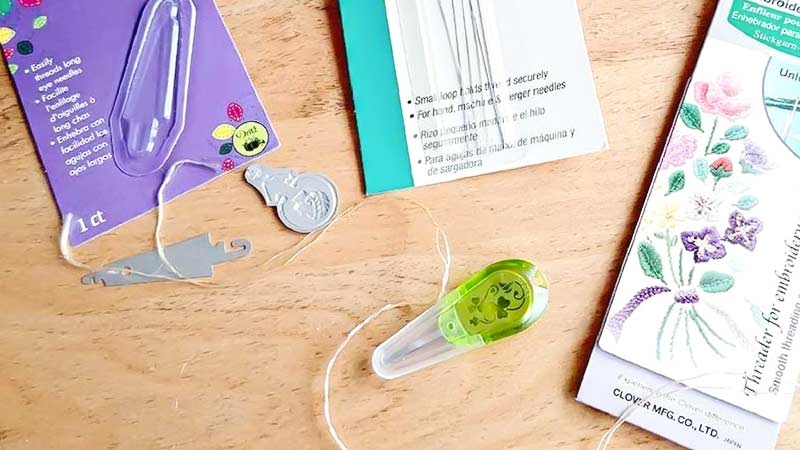
In sewing, needle threaders are available to assist with threading needles, making the process more accessible and efficient.
Here are some common types of needle threaders:
Manual Needle Threaders
Manual needle threaders are the most basic and affordable. Typically consisting of a thin wire loop attached to a handle or pendant, these threaders require manual insertion of the loop through the eye of the needle.
They are versatile and suitable for a wide range of needles and threads.
Automatic Needle Threaders
Automatic needle threaders offer a more advanced solution. Often integrated into sewing machines or sergers, they feature a mechanism that automates threading.
The thread is effortlessly guided through the needle eye with a simple push of a button or lever. Standalone automatic threaders are also available.
LED Needle Threaders
LED needle threaders enhance visibility by incorporating LED lights into the traditional design. The LED light illuminates the needle eye, making it easier to see and thread needles, especially in low-light conditions or with dark fabrics.
These threaders are battery-operated, and some models allow for LED component replacement.
Magnifying Needle Threaders
Designed to address visibility challenges, magnifying needle threaders combine a built-in magnifying glass with the traditional manual threader design.
The magnifying glass enlarges the needle eye, aiding visibility, particularly for individuals with poor eyesight or when working with fine needles and threads.
Specialized Needle Threaders
Specialized needle threaders cater to specific sewing projects or needle types. These threaders may have unique features tailored to particular challenges, such as those encountered in embroidery.
They provide targeted solutions for intricate and specialized sewing tasks.
Advantages of Using a Needle Threader in Sewing
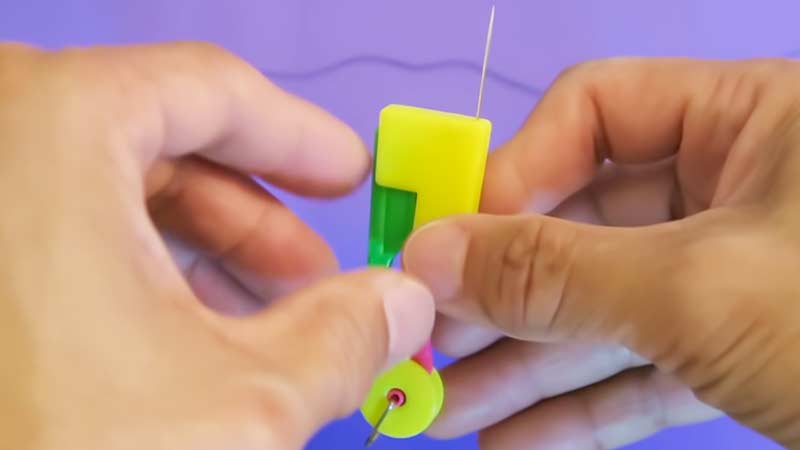
Using a needle threader in sewing offers several advantages, making the threading process more efficient and accessible. Here are some key benefits:
Time-Saving
Needle threaders significantly expedite the threading process. With a needle threader, guiding the thread through the small eye of the needle becomes quick and effortless, saving valuable time during sewing projects.
Accessibility for All
Individuals with poor eyesight or shaky hands often find threading needles challenging. A needle threader provides a solution, making sewing more accessible for a broader range of people by reducing the precision required for manual threading.
Suitable for Fine Threads and Small Needles
Threading fine threads through small needle eyes can be a delicate task. Needle threaders are designed to handle these challenges, ensuring that even the finest threads can be threaded through the needle effortlessly.
Versatility
Needle threaders are versatile tools that can be used with various types and sizes of needles. Whether working with hand-sewing, machine, or specialized needles for embroidery, a needle threader can accommodate different needle types.
Reduced Frustration
Threading needles manually, especially when the thread frays or the needle eye is small, can lead to frustration. A needle threader minimizes this frustration by consistently providing a straightforward and reliable method for threading needles.
Ideal for Intricate Projects
A needle threader becomes an invaluable tool in intricate sewing projects requiring numerous thread changes. It streamlines the process, allowing the sewer to focus more on the project details rather than struggling with threading.
Convenient for Multiple Threading
Sewers working on projects that involve frequent needle changes, such as quilting or embroidery, find needle threaders particularly convenient. The ease of threading encourages smoother transitions between different threads and needles.
Perfect for Beginners
For those new to sewing, threading needles manually can be a daunting task. A needle threader provides an excellent introduction to sewing, reducing the initial challenges and allowing beginners to focus on other aspects of the craft.
Long-Term Hand Health
Continuous manual threading can strain the hands and fingers, especially for those with arthritis. Using a needle threader can contribute to long-term hand health by minimizing repetitive finger stress.
Enhanced Precision
The precision of the threading process is enhanced with a needle threader. This particularly benefits projects that demand accuracy, such as intricate embroidery or detailed stitching.
How Can You Effectively Use a Needle Threader in Sewing?
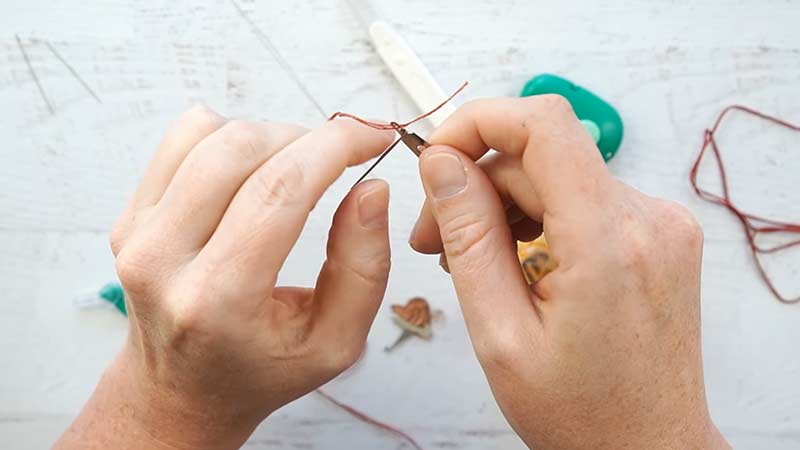
Effectively using a needle threader in sewing involves a few simple steps and considerations to ensure a smooth threading process.
Here’s a guide on how to use a needle threader effectively:
Select the Right Type of Needle Threader
Choose a needle threader that suits the type and size of your needle. Different threaders may have variations in design and compatibility, so match the tool to your specific sewing needs.
Hold the Needle Steadily
Hold the needle securely with one hand. You can use a pin cushion, a magnet, or your fingers to keep the needle steady and in the right position for threading.
Prepare the Thread
Ensure that the end of the thread is cut cleanly. If the thread end is frayed or uneven, inserting it through the wire loop of the needle threader may be challenging.
Insert the Wire Loop Through the Needle’s Eye
Insert the wire loop of the needle threader through the eye of the needle from the front to the back. Make sure the wire loop is fully through the needle eye.
Place the Thread Through the Wire Loop
Thread the end of your prepared thread through the wire loop of the needle threader. Ensure that the thread is properly placed within the loop for effective threading.
Pull the Wire Loop Back Through
Gently pull the wire loop back through the eye of the needle. The flexibility of the wire loop allows it to navigate through the small eye of the needle, bringing the thread with it.
Remove the Wire Loop
After successfully pulling the thread through the needle eye, carefully remove the wire loop from the thread and the needle. Ensure that the thread remains securely threaded through the needle.
Avoid Excessive Force
Be gentle when pulling the wire loop through the needle eye. Excessive force may damage the needle threader or cause it to break, especially in the case of manual threaders.
Store Properly
Store your needle threader safely to protect it from dust, dirt, and damage when not in use. This can prolong the tool’s life and keep it in good working condition.
FAQs
Can needle threaders be used with sewing machines?
Automatic needle threaders are often integrated into sewing machines, but standalone ones are also available for various machines.
Can a needle threader be used with embroidery needles?
Yes, some needle threaders are designed specifically for embroidery needles, with features tailored to handle the unique characteristics of these needles.
Can needle threaders handle thick fabrics like denim or canvas?
Needle threaders can assist in threading needles for thick fabrics, but choosing a sturdy needle threader designed for heavier materials is crucial.
Are there needle threaders suitable for children learning to sew?
Yes, some needle threaders are designed with user-friendly features, making them suitable for children or beginners learning to sew.
To Recap
The needle threader emerges as a modest yet game-changing tool in sewing. Its ability to simplify the often intricate process of threading needles, especially for those with visual or dexterity challenges, cannot be overstated.
As we unravel the significance of the needle threader, it becomes evident that this unassuming device contributes not only to the efficiency of sewing projects but also to the inclusivity of the craft.
Seamstresses and crafters find solace in its reliable assistance, turning what was once a potential source of frustration into a seamless and enjoyable journey through sewing.
Though small in stature, the needle threader has a significant impact on the tapestry of creative expression.
Leave a Reply